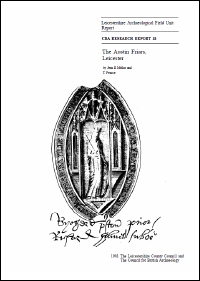CBA Research Reports
Council for British Archaeology, 2000. (updated 2020) https://doi.org/10.5284/1000332. How to cite using this DOI
Data copyright © Council for British Archaeology unless otherwise stated
This work is licensed under the ADS Terms of Use and Access.
Primary contact
Council for British Archaeology
92 Micklegate
York
YO1 6JX
UK
Tel: 01904 671417
Resource identifiers
- ADS Collection: 281
- DOI:https://doi.org/10.5284/1000332
- How to cite using this DOI
The Austin Friars, Leicester
Jean E Mellor and T Pearce
CBA Research Report No 35 (1981)
Leicestershire Archaeological Field Unit: Report 1
ISBN 0 900312 94 7
Abstract

Few excavations have been undertaken on urban friaries and there are many aspects of the buildings and economy of the mendicant houses that are imperfectly understood. The potential of these houses within medieval archaeology has still to be fully realised. The advantages of continuous corporate existence and of regular documentary references both to the religious activity and to involvement in secular concerns makes this a worthwhile subject to tackle. There is a further advantage in that the friars were late to arrive in western Europe and had a finite length of stay in Britain; their existence was compressed within three centuries. Their architectural and archaeological record falls between closely defined limits.
Contents
- Title pages
- Contents(p v)
- Preface (p viii)
- Introduction by Lawrence Butler (p viii)
- The documentary evidence by Janet Martin (pp 1-5)
- The excavations by Jean E Mellor and T Pearce (pp 5-46)
- The small finds - structural by Patrick Clay (pp 46-52)
- The roof tiles by Claire E Allin (pp 52-70)
- The floor tiles by John Lucas (pp 70-78)
- The mortar analyses by Jean E Mellor (pp 78-81)
- The pottery by Rosemary R Woodland (pp 81-130)
- The small finds - non-structural by Patrick Clay (pp 130-145)
- The leather by Claire E Allin (pp 145-168 & Microfiche 1)
- The human bones by Ann Stirland (pp 168-169 & Microfiche 1)
- The environmental evidence by Maureen Girling (pp 169-173 & Microfiche 1)
- The mammal, bird and fish bones by Clare R Thawley (pp 173-175 & Microfiche 2)
Download report
| The Austin Friars, Leicester (CBA Research Report 35) | 18 Mb | |
| The Austin Friars, Leicester (microfiche) | 13 Mb |







